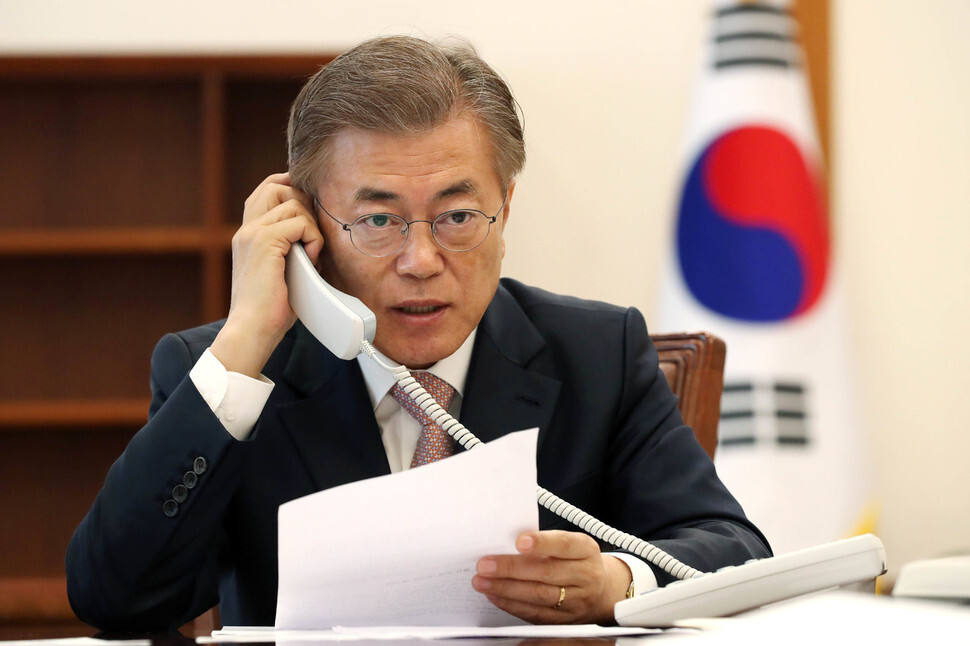hankyoreh
Links to other country sites 다른 나라 사이트 링크
Pres. Moon starting diplomatic moves to address THAAD issue with China

South Korea President Moon Jae-in went to work on diplomatically addressing the THAAD issue in a May 11 telephone conversation with Chinese President Xi Jinping with the announcement of plans to send a special envoy to China to discuss THAAD and the North Korean nuclear issue.
A step forward from his remarks that he would “sincerely negotiate with the US and China” on THAAD in his inaugural address the day before, Moon’s plan suggests Seoul is launching preparations for dialogue with Beijing.
Moon did not offer any cut-and-dried solutions on THAAD during his election campaign, offering instead only the bare outline of a resolution process on the issue. Initially, Moon had stated his opposition to the THAAD deployment. But during his presidential campaign, he adopted an approach of not clearly stating whether he was for or against it. Every time he was attacked over this change in positions, he responded that he needed a “strategically noncommittal attitude to use as a diplomatic bargaining chip later.” In his election platform, he pledged to pursue a National Assembly ratification of the deployment. From these statements, Moon appears likely to submit the issue to public debate at home as it goes through ratification by the National Assembly. Diplomatically, he is expected to use what he finds about public opinion as he goes through the procedures of discussions with Washington and Beijing.
US Forces Korea has already deployed key THAAD components in Seongju, North Gyeongsang Province, including a fire control unit, X-band radar, and two launchers. Ministry of National Defense spokesperson Moon Sang-kyun said on May 2 that the THAAD components were “able to perform initial operation capabilities.”
Additional THAAD deliveries by USFK have reportedly been suspended.
“There’s an ‘all-stop’ in place until there have been directions from the new administration,” a senior Defense Ministry official said.
But most analysts agree it is realistically unlikely the THAAD components that have already been put in place will be withdrawn.
At the same time, US President Donald Trump’s demand for US$1 billion from South Korea in THAAD deployment costs naturally means additional discussions will be needed between South Korea and the US. China’s position against THAAD is clear, with Foreign Ministry spokesperson Geng Shuang reaffirming on May 10 that the stance of Beijing has been “clear and consistent.” But Moon’s inauguration has had the Global Times and other Chinese media expressing hopes for a resolution on the THAAD issue. With the current awkwardness in bilateral relations becoming more of a burden as it wears on, Beijing may welcome Seoul’s efforts to find a solution.
By Park Byong-su, senior staff writer
Please direct questions or comments to [english@hani.co.kr]

Editorial・opinion
![[Column] Park Geun-hye déjà vu in Yoon Suk-yeol [Column] Park Geun-hye déjà vu in Yoon Suk-yeol](https://flexible.img.hani.co.kr/flexible/normal/500/300/imgdb/original/2024/0424/651713945113788.jpg) [Column] Park Geun-hye déjà vu in Yoon Suk-yeol
[Column] Park Geun-hye déjà vu in Yoon Suk-yeol![[Editorial] New weight of N. Korea’s nuclear threats makes dialogue all the more urgent [Editorial] New weight of N. Korea’s nuclear threats makes dialogue all the more urgent](https://flexible.img.hani.co.kr/flexible/normal/500/300/imgdb/original/2024/0424/7317139454662664.jpg) [Editorial] New weight of N. Korea’s nuclear threats makes dialogue all the more urgent
[Editorial] New weight of N. Korea’s nuclear threats makes dialogue all the more urgent- [Guest essay] The real reason Korea’s new right wants to dub Rhee a founding father
- [Column] ‘Choson’: Is it time we start referring to N. Korea in its own terms?
- [Editorial] Japan’s rewriting of history with Korea has gone too far
- [Column] The president’s questionable capacity for dialogue
- [Column] Are chaebol firms just pizza pies for families to divvy up as they please?
- [Column] Has Korea, too, crossed the Rubicon on China?
- [Correspondent’s column] In Japan’s alliance with US, echoes of its past alliances with UK
- [Editorial] Does Yoon think the Korean public is wrong?
Most viewed articles
- 1‘We must say no’: Seoul defense chief on Korean, USFK involvement in hypothetical Taiwan crisis
- 2N. Korean delegation’s trip to Iran shows how Pyongyang is leveraging ties with Moscow
- 3‘Weddingflation’ breaks the bank for Korean couples-to-be
- 4Korea sees more deaths than births for 52nd consecutive month in February
- 5[Column] Park Geun-hye déjà vu in Yoon Suk-yeol
- 6Will NewJeans end up collateral damage in internal feud at K-pop juggernaut Hybe?
- 7[Column] Has Korea, too, crossed the Rubicon on China?
- 8Amnesty notes ‘erosion’ of freedom of expression in Korea in annual human rights report
- 9Samsung barricades office as unionized workers strike for better conditions
- 10[Column] The clock is ticking for Korea’s first lady